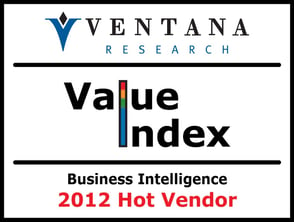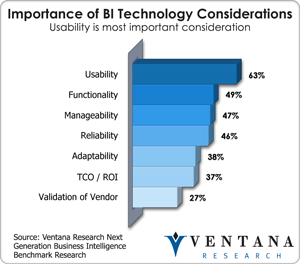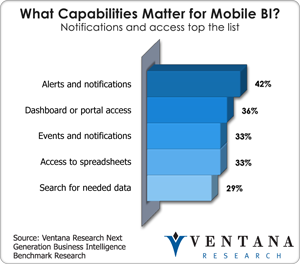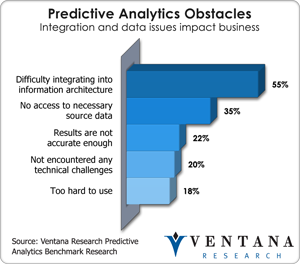Information Builders (IBI) was highest ranked vendor in Ventana Research’s Business Intelligence Value Index for 2012. The combination of data integration, business analytics, visual and data  discovery and performance management software in a single framework allows the company to address a range of both IT and business user needs and gives it a measure of advantage in an intensely competitive market. At the same time, emerging trends are disrupting the BI category, which seemed mature not long ago. The 2013 IBI user conference in Orlando showed how the company is addressing these industry trends. (For analysis of last year’s event, see my colleague Mark Smith’s comments).
discovery and performance management software in a single framework allows the company to address a range of both IT and business user needs and gives it a measure of advantage in an intensely competitive market. At the same time, emerging trends are disrupting the BI category, which seemed mature not long ago. The 2013 IBI user conference in Orlando showed how the company is addressing these industry trends. (For analysis of last year’s event, see my colleague Mark Smith’s comments).
At the core of the IBI strategy are its WebFocus 8.0 platform and iWay, its information management suite of software. Our benchmark research into Business Technology Innovation shows that data preparation and quality are critical challenges and time consuming activities impacting analysts in 42 percent of organizations, so information management must be part of any general discussion of business intelligence. The latest release, iWay 7, was announced at the conference. It can integrate more than 300 data sources using prebuilt adapters and handles data preparation and quality and multidomain master data management. Management spun off iWay into a separate operating company but brought it back into the core business recently as executives recognized the trend toward big data and what we call information optimization. The combination of data integration with business intelligence is a critical factor for business intelligence companies in large part because big data integration is essential to big data analytics. The ability to denormalize data and combine diverse data into a wide single view of an analytical data set is an important aspect of big data analytics. Information Builders uses the iWay and a columnar database called Hyperstage running on commodity servers to handle these big data challenges.
The picture of how WebFocus 8 addresses emerging BI trends is becoming clearer. The first of these trends is the necessity for self- service and ease of use in business intelligence tools. Our next-generation business intelligence benchmark research shows that usability is the most critical buying criterion for nearly two-thirds (63%) of organizations. IBI has prepared its applications for a broad user base through capabilities that enable the Web-based WebFocus to deliver features normally associated with desktop software. Additional functionality provided through InfoAssist, a component of WebFocus 8, helps power users explore data, define metrics and publish information without coding. Additionally, the suite now includes Visual Discovery, which has data mashup and discovery capabilities that enable analysts to look at data without a predefined schema and find relationships that may not have been apparent previously. Location analytics technology from ESRI, a long-time leader in location intelligence, can be incorporated into the analysis as well. Location analytics has not been given a lot of attention, but it is gaining more recognition, according to our recent location analytics benchmark research. Finally, Magnify offers a search capability for both structured and unstructured data, which helps users find business content across the enterprise. While Magnify presents a valuable search tool for analysts, the product appears to be suffering from lack of awareness. In a session on self-service BI, few attendees had even heard of it.
service and ease of use in business intelligence tools. Our next-generation business intelligence benchmark research shows that usability is the most critical buying criterion for nearly two-thirds (63%) of organizations. IBI has prepared its applications for a broad user base through capabilities that enable the Web-based WebFocus to deliver features normally associated with desktop software. Additional functionality provided through InfoAssist, a component of WebFocus 8, helps power users explore data, define metrics and publish information without coding. Additionally, the suite now includes Visual Discovery, which has data mashup and discovery capabilities that enable analysts to look at data without a predefined schema and find relationships that may not have been apparent previously. Location analytics technology from ESRI, a long-time leader in location intelligence, can be incorporated into the analysis as well. Location analytics has not been given a lot of attention, but it is gaining more recognition, according to our recent location analytics benchmark research. Finally, Magnify offers a search capability for both structured and unstructured data, which helps users find business content across the enterprise. While Magnify presents a valuable search tool for analysts, the product appears to be suffering from lack of awareness. In a session on self-service BI, few attendees had even heard of it.
Analytics applied to social media is another hot topic in business, and IBI has made significant advancements with its Social Media Integration application, also part of WebFocus 8. It enables users to examine posts, blogs and other social data to detect patterns in customer opinions. Sentiment algorithms that interpret and quantify the inherent complexities of language are provided as a third-party Web service or a REST adapter. Users can search via the Magnify tool and receive a robust contextual inquiry experience with tag clouds, quantitative information around mentions, and sentiment on a scale from very negative to very positive. Users can assign thresholds based on numeric value and assign appropriate stakeholders to follow up. Many marketing departments are using ad-hoc tools to drive these types of initiatives, but ultimately it makes more sense to place these queries within the context of their business intelligence initiatives; social information alone has limited value, but when married with internal metrics such as customer lifetime value, it has much more impact.
On another increasingly important front, mobile business intelligence ranks as a business priority among the six areas of technology innovation that Ventana Research studies. IBI takes a hybrid HTML5 approach to mobile intelligence and analytics. That is, a user downloads a native shell from an online store associated with a particular device, and then the content is rendered through the browser via HTML5. Seeing the mobile trend early, IBI completely rewrote its charting engine to support HTML5 and Mobile Favs on the native side. This method exploits native gestures, while at the same time designers benefit from a develop once, deploy anywhere strategy. While our research shows that mobile users still prefer native applications over HTML5, the pendulum may be swinging. In December 2012 W3C, the body that oversees the HTML5 standard, agreed on candidate recommendations, which means that important companies such as Apple, Google and Microsoft have accepted standards to be implemented by the larger development community. This will help HTML5 vendors including IBI. IBI’s Mobile strategy provides robust dashboard and portal access which is a high priority for 36% of users, however IBI should work to make improvements that leverage prescriptive analytics and operational capabilities to drive proactive alerts and notifications which are the top capabilities mentioned by 42% of mobile BI users.
approach to mobile intelligence and analytics. That is, a user downloads a native shell from an online store associated with a particular device, and then the content is rendered through the browser via HTML5. Seeing the mobile trend early, IBI completely rewrote its charting engine to support HTML5 and Mobile Favs on the native side. This method exploits native gestures, while at the same time designers benefit from a develop once, deploy anywhere strategy. While our research shows that mobile users still prefer native applications over HTML5, the pendulum may be swinging. In December 2012 W3C, the body that oversees the HTML5 standard, agreed on candidate recommendations, which means that important companies such as Apple, Google and Microsoft have accepted standards to be implemented by the larger development community. This will help HTML5 vendors including IBI. IBI’s Mobile strategy provides robust dashboard and portal access which is a high priority for 36% of users, however IBI should work to make improvements that leverage prescriptive analytics and operational capabilities to drive proactive alerts and notifications which are the top capabilities mentioned by 42% of mobile BI users.
IBI’s cloud initiative is in the form of platform as a service (PaaS). As opposed to infrastructure as a service or software as a service, PaaS provides both infrastructure and a development environment for BI applications. IBI’s product encompasses service level agreements for testing, validation and production environments with performance tuning, database provisioning and network management. The company has 10 international data centers, which helps to overcome regulatory challenges associated with international data movement. IBI does not have a “pay as you go” usage model but treats it more as a professional service based on assessment. This matches the company’s intended brand image as a service-oriented provider. In the bigger picture of cloud computing, BI is a laggard with only a few percent of participants in our research actually having adopted cloud-based BI. Security and data movement are the biggest perceived obstacles among those organizations.
In the area of predictive analytics, IBI has embedded RStat, which uses the open source R statistical language and can be accessed  within Developer Studio or as part of its WebFocus BI product. While the customers I spoke with are still building their models outside the IBI system, they suggested that the models will be translated back into RStat and scored within the IBI system. Predictive analytics is a challenge for many business intelligence vendors, which until now have dealt in historical data and simple descriptive statistics. Traditional relational databases are able to provide basic descriptive functions such as min, max, sum and mean, but more advanced functions have been beyond their scope. Our benchmark research on predictive analytics shows that the difficulty of integrating predictive analytics into a current information architecture is the biggest obstacle to predictive analytics for more than half (55%) of organizations.
within Developer Studio or as part of its WebFocus BI product. While the customers I spoke with are still building their models outside the IBI system, they suggested that the models will be translated back into RStat and scored within the IBI system. Predictive analytics is a challenge for many business intelligence vendors, which until now have dealt in historical data and simple descriptive statistics. Traditional relational databases are able to provide basic descriptive functions such as min, max, sum and mean, but more advanced functions have been beyond their scope. Our benchmark research on predictive analytics shows that the difficulty of integrating predictive analytics into a current information architecture is the biggest obstacle to predictive analytics for more than half (55%) of organizations.
In a broader analytics discussion with its product leaders Kevin Quinn and Rado Katorov, an interesting analytic concept that bears on data discovery was revealed. Simpson’s Paradox is the idea that a trend that appears in a single group disappears, and often reverses itself, when combined with other data. For instance, in 1973, the University of California Berkeley was sued for discrimination against women based on the fact that 44 percent of male applicants were admitted but only 35 percent of women were admitted. While the difference is indeed significant, when the data is looked at on a departmental basis, an interesting causal variable emerges. That is, men were applying to the easier programs and women were applying to the more difficult programs. Thus it was concluded that the disparity was not due to discrimination but rather to men who applied to the university that year may simply have been a bit lazier than the women applying. The point for analytics is that many discovery tools in the market today often rely on people to make discoveries based on single groupings of variables, and such discoveries may be misleading or worse. IBI’s approach to this issue is to use data reduction techniques such as cluster analysis that allow the data to group itself in an a-priori manner, thus making it easier for the analyst to recognize important patterns among groups of variables rather than just single variables. In the Berkeley admission example, for instance, IBI’s system presumably would have linked the difficulty of the program with gender, and that insight could perhaps have prevented the lawsuit from even being filed.
In sum, IBI has a strong base in large and midsize companies due to its posture as more than a BI company. Our recent recognition of Scott Franzel at OFS Brands with the 2013 Overall IT Leadership Award for their use of Information Builders is another example of its business intelligence software helping organizations and individuals be successful. Its success in extending BI to a broader base of stakeholders in both B2B and B2C markets allows the company to keep up with current trends and is at the center of the company’s big data and analytics initiatives. Companies that have already deployed WebFocus should look at the extended capabilities of version 8 and in particular the opportunity to brand information as a service throughout the organization. On a broader basis, any business group or IT department that is trying to take a customer-driven approach to business intelligence should consider IBI.
posture as more than a BI company. Our recent recognition of Scott Franzel at OFS Brands with the 2013 Overall IT Leadership Award for their use of Information Builders is another example of its business intelligence software helping organizations and individuals be successful. Its success in extending BI to a broader base of stakeholders in both B2B and B2C markets allows the company to keep up with current trends and is at the center of the company’s big data and analytics initiatives. Companies that have already deployed WebFocus should look at the extended capabilities of version 8 and in particular the opportunity to brand information as a service throughout the organization. On a broader basis, any business group or IT department that is trying to take a customer-driven approach to business intelligence should consider IBI.
Regards,
Tony Cosentino
VP and Research Director














